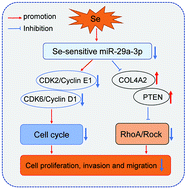Selenium-mediated gga-miR-29a-3p regulates LMH cell proliferation, invasion, and migration by targeting COL4A2†
Abstract
Selenium (Se) is an essential trace element that has several functions in cellular processes related to cancer prevention. While the cancericidal effect of Se has been reported in liver cancer, the mechanism has not been clarified. MiR-29a has widely been reported as a tumor suppressor; however, it also acts as a carcinogenic agent by increasing cell invasion in human epithelial cancer cells and hepatoma cells. In a previous study, we found that miR-29a-3p is a Se-sensitive miRNA. However, its effect in the chicken hepatocellular carcinoma cell line (LMH) is still unknown. In the present study, we found that the expression of miR-29a-3p in LMH cells was decreased by Se supplementation and increased under Se-deficient conditions. Flow cytometry and CCK-8 results suggested that Se decreased LMH cell proliferation induced by miR-29a-3p overexpression. Transwell and gap-closure assays implied that Se mediated LMH cell invasion and migration by downregulating miR-29a-3p. Quantitative real-time polymerase chain reaction and Western blotting results suggested that Se mitigated miR-29a-3p overexpression-induced LMH cell proliferation by downregulating CDK2, cyclin-D1, CDK6, and cyclin-E1. We further demonstrated that collagen type IV alpha 2 (COL4A2) is a target gene of miR-29a-3p. COL4A2 activates the RhoA/ROCK pathway to promote LMH cell invasion and migration. In conclusion, Se mediated miR-29a-3p overexpression induced LMH cell invasion and migration by targeting COL4A2 to inactivate the RhoA/ROCK pathway.



 Please wait while we load your content...
Please wait while we load your content...